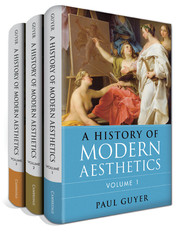Book contents
- Volume 1 The Eighteenth Century
- Volume 2 The Nineteenth Century
- Volume 3 The Twentieth Century
- Frontmatter
- Contents
- Acknowledgments
- Introduction
- Part One German Aesthetics in the Twentieth Century
- Part Two Aesthetics in Britain until World War II
- Part Three American Aesthetics in the First Half of the Twentieth Century
- 6 Santayana
- 7 The American Reception of Expression Theory I
- 8 Dewey
- 9 The American Reception of Expression Theory II
- 10 After Dewey and Cassirer
- Part Four Wittgenstein and After
- Bibliography
- References
8 - Dewey
from Part Three - American Aesthetics in the First Half of the Twentieth Century
Published online by Cambridge University Press: 05 June 2015
- Volume 1 The Eighteenth Century
- Volume 2 The Nineteenth Century
- Volume 3 The Twentieth Century
- Frontmatter
- Contents
- Acknowledgments
- Introduction
- Part One German Aesthetics in the Twentieth Century
- Part Two Aesthetics in Britain until World War II
- Part Three American Aesthetics in the First Half of the Twentieth Century
- 6 Santayana
- 7 The American Reception of Expression Theory I
- 8 Dewey
- 9 The American Reception of Expression Theory II
- 10 After Dewey and Cassirer
- Part Four Wittgenstein and After
- Bibliography
- References
Summary
John Dewey (1859–1952) was the only one of the founding triumvirate of American pragmatists (the others being Charles Sanders Peirce and William James) to devote a book to aesthetics, and even then he came to the subject late in his career: Art as Experience was first presented in the lecture series named after William James at Harvard in 1931 and published as a book in 1934, when Dewey was already seventy-five years old, and has remained ever since one of the most widely read of Dewey’s numerous works and one of the most widely read works in the history of American aesthetics. At one point in the book, Dewey largely dissociates himself from what he himself calls the play theory of art, arguing that although “the truth in the play theory is its emphasis upon the unconstrained character of esthetic experience,” it remains locked within “its opposition of freedom and necessity, of spontaneity and order,” an opposition going “back to the same dualism between subject and object that infects the make-believe theory” or the “dream theory” of art – theories that art is the product of imagination unconstrained by any of the demands of ordinary life and its conditions. Throughout his career, but especially in his culminating philosophical works of the 1920s and early 1930s, Dewey aimed to undermine virtually all traditional philosophical dualisms such as those between subject and object, theory and practice, and for that matter work and play – the critique of the last distinction being crucial to Dewey’s enormous influence as an educational theorist. So although he appreciated the emphasis on the spontaneity of the imagination in the play theory of art, he decried what he considered to be “its underlying note ... the idea that esthetic experience is” primarily “a release and escape from the pressure of ‘reality’” and its “failure to recognize that esthetic experience involves a definite reconstruction of objective materials,” that is, the “artistic activity” that “is significantly called the work of art.”
- Type
- Chapter
- Information
- A History of Modern Aesthetics , pp. 309 - 334Publisher: Cambridge University PressPrint publication year: 2014



